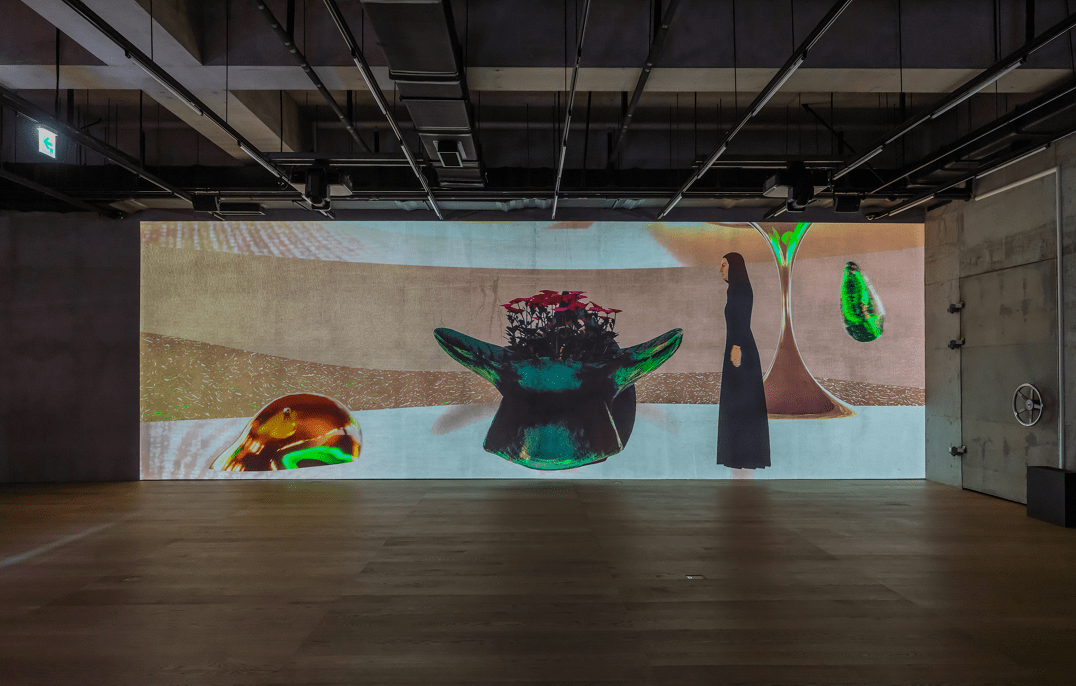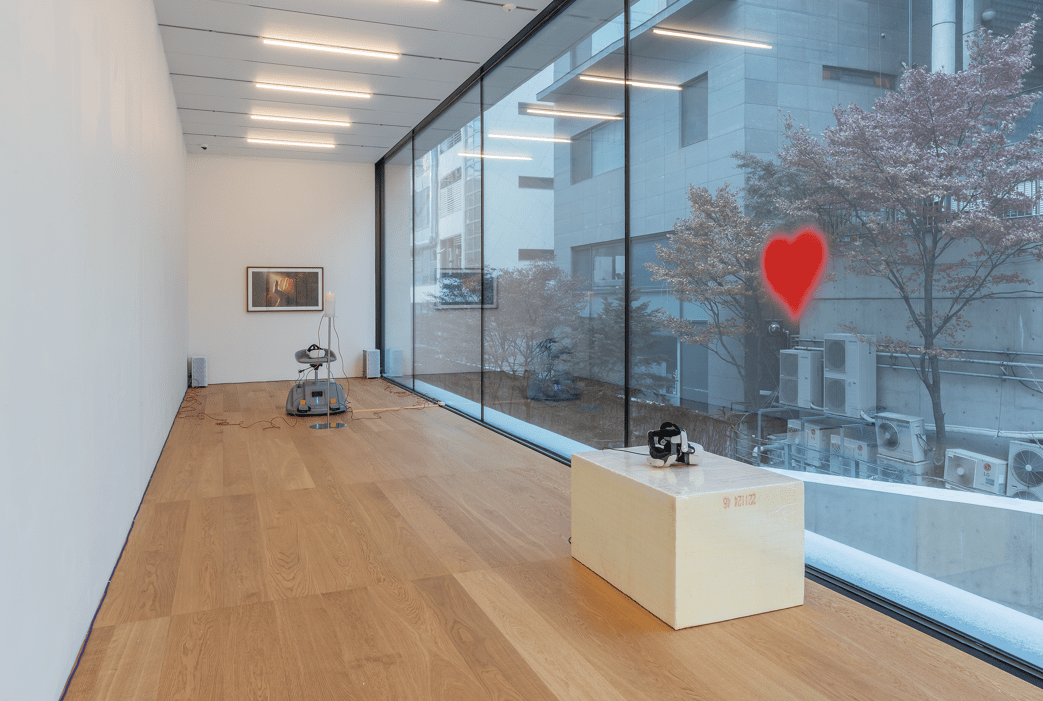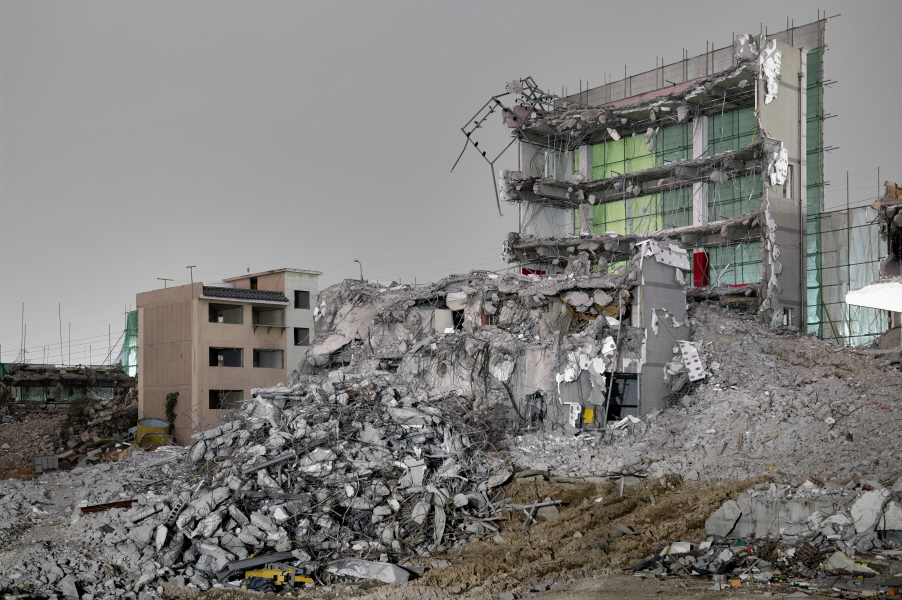 Installation view of SongEun's Welcome Room. © SONGEUN Art and Cultural Foundation and the Artists. All rights reserved.
Installation view of SongEun's Welcome Room. © SONGEUN Art and Cultural Foundation and the Artists. All rights reserved.There are many ways to recognize outstanding emerging artists. Looking at art award recipients could be one way to identify emerging artists with exceptional artistic achievements, especially for awards given by reputable institutions that have been running award programs for many years.
There are several art awards in Korea. Among them, the SONGEUN Art Award of the SONGEUN Art and Cultural Foundation is celebrating its 22nd anniversary this year by holding The 22nd SONGEUN Art Award Exhibition, which features the works of 20 exceptional young artists from December 21, 2022, to February 18, 2023, to determine the 2022 winner in January of the following year.
The annual award program has been motivating and supporting emerging contemporary Korean artists since 2001. In 2021, in commemoration of its 20th anniversary, the SONGEUN Art Award program was reorganized from showcasing the works of four candidates to showcasing the works of 20 artists to more accurately reflect the trend of contemporary art in Korea.
The 20 artists who made it to the finals have not only recently been active in the contemporary art world but have also added a new paradigm to the contemporary Korean art landscape. Through the works of artists supported by the SONGEUN Art and Cultural Foundation, this exhibition offers a glimpse into the various aspects of Korean contemporary art.
A total of 503 applicants applied for this year’s award program. The twenty artists in the finals include Jaewook Koh, Youngle Keem, Hyun-Seok Kim, Eunjoo Rho, Grim Park, Rahm Parc, Yunju Park, Hye-Kyung Son, Sungseok Ahn, Anna Han, Jade Sujin Lee, Heejoon Lee, Jongwan Jang, Bokyung Chun, Hye-Rim Jun, Hye-Joo Jun, Jihyun Jung, Heemin Chung, Go Eun Che, and Wonhae Hwang. The works of these artists incorporate a wide range of media, such as painting, sculpture, installation, photography, video, and sound.
The twenty artists were supported by the foundation to participate in the exhibition. The final winner will be selected through a screening process during the exhibition period and will then receive various forms of assistance for the advancement of their artistic careers. The final winner will be announced in January 2023.
 고재욱(Jaewook Koh), '모범적인 조연들' 전분 플라스틱에 유채, 가변설치. ⓒSONGEUN Art and Cultural Foundation and the Artists. All rights reserved.
고재욱(Jaewook Koh), '모범적인 조연들' 전분 플라스틱에 유채, 가변설치. ⓒSONGEUN Art and Cultural Foundation and the Artists. All rights reserved.Through his works, Jaewook Koh (b. 1983) humorously conveys the discomfort of living in contemporary Korean society or the absurdity of the social system.
His most representative projects include On Your Mark (2009), where he sends a life-size image of himself to foreign acquaintances and asks them to take pictures with it, revealing the psychology of wanting to be remembered by others. Another project is Die for which was in a form of a karaoke room that visitors could use. This project awakens the desire to escape solitude and gain the attention of others.
In this exhibition, the artist created life-size sculptures of people of color who appear in console games, especially Asians. Through the images in the game media, it compels us to consider the Western-centric perspectives that form the foundation of our perception.
 김영글(Youngle Keem), '머뭇거리는 사이', 2022, 책상, 의자, 시들어가는 꽃과 꽃병, 종이에 펜으로 쓴 시, 가변설치. ⓒSONGEUN Art and Cultural Foundation and the Artists. All rights reserved.
김영글(Youngle Keem), '머뭇거리는 사이', 2022, 책상, 의자, 시들어가는 꽃과 꽃병, 종이에 펜으로 쓴 시, 가변설치. ⓒSONGEUN Art and Cultural Foundation and the Artists. All rights reserved.Youngle Keem (b. 1980), who majored in literature and fine arts, attributes great significance to both visual and linguistic elements in her works.
Keem presents literary imagination through various media, such as video, installation, and photography, or interprets cultural images through the act of writing. For example, in works such as the Stone Exploration Series (2018–2019), the artist collects various human interpretations of stones, organizes them in the form of a photo archive, and presents a written story about them.
In SONGEUN, Keem reveals the lessons learned from her fundamental concerns as an artist. In order to participate in an exhibition, the story has to be told in various forms. There were occasions when the artist believed this to be impossible. So, the artist presents this impossibility in the form of an installation at the exhibition.
Hyun-Seok Kim (b. 1988) focuses on the subject of the “contemporaneity of technology.” Kim asks questions regarding the images and meanings reproduced by contemporary media, investigates the specificity of modern media technology, and reveals the inherent motility of images created by technology.
 김현석(Hyun-Seok Kim), '환영의 변증법', 2022, 2채널 비디오, UHD, 컬러, 반복, 인공지능 모델(gpt-3, Stable diffusion), 167x80x100cm. ⓒSONGEUN Art and Cultural Foundation and the Artists. All rights reserved.
김현석(Hyun-Seok Kim), '환영의 변증법', 2022, 2채널 비디오, UHD, 컬러, 반복, 인공지능 모델(gpt-3, Stable diffusion), 167x80x100cm. ⓒSONGEUN Art and Cultural Foundation and the Artists. All rights reserved.In this exhibition, Kim presents a two-channel video installation based on the rapidly evolving artificial intelligence model. Dora and Alice, two virtual characters created by artificial intelligence models on two monitor screens, are conversing while standing back to back. They forecast future vision and perception by exchanging questions and answers about “image” and “language.”
 노은주(Eunjoo Rho), '사물들', 2022, 캔버스에 유채, 193.9x450cm. ⓒSONGEUN Art and Cultural Foundation and the Artists. All rights reserved.
노은주(Eunjoo Rho), '사물들', 2022, 캔버스에 유채, 193.9x450cm. ⓒSONGEUN Art and Cultural Foundation and the Artists. All rights reserved.Focusing on drawings and paintings, Eunjoo Rho (b. 1988) explores the landscape that makes up the city as well as the basic forms contained within it. The artist draws the surrounding objects, creates miniature sculptures using 3D modeling, rearranges them according to the artist’s own standards, and transfers them back to painting.
Pieces of wood or steel used as building materials, flowers that appear to be withering, and structures that do not know if they are hardened or melted express complex emotions such as helplessness, boredom, and anxiety. The emotions and tension emanating from the unfinished-like paintings are also revealed through the use of cold colors, theatrical eyes, and thin but sharp forms. The artist’s still-life paintings can be seen everywhere, but she also paints unfamiliar landscapes somewhere.
 박그림(Grim Park), '심호도 춘수(尋虎圖_春秀)', 2022, 비단에 담채, 250x340cm. ⓒSONGEUN Art and Cultural Foundation and the Artists. All rights reserved.
박그림(Grim Park), '심호도 춘수(尋虎圖_春秀)', 2022, 비단에 담채, 250x340cm. ⓒSONGEUN Art and Cultural Foundation and the Artists. All rights reserved.Grim Park (b. 1987) uses techniques and themes from traditional Korean Buddhist paintings to tell individual stories that can be extended to social issues related to LGBTQIA+. The process of delicately coloring the front and back sides of the silk multiple times contains the non-mainstream genre of Buddhist painting, the obsolete apprenticeship method of work, the artist’s sexual identity issue, and his desire for beauty.
The Simhodo Chunsu in the exhibition was inspired by the Simwoodo (searching for the ox to find one’s true nature) murals usually painted behind Buddhist temples. Instead of the ox, the artist drew a tiger that symbolizes himself. The three-panel screen, reminiscent of a painting of Buddha, reveals the story of the artist’s own conflict and sublimation.
 박아람(Rahm Parc), '그림들', 2022, 철판에 페인트, 3면 각, 180x180x0.7cm. ⓒSONGEUN Art and Cultural Foundation and the Artists. All rights reserved.
박아람(Rahm Parc), '그림들', 2022, 철판에 페인트, 3면 각, 180x180x0.7cm. ⓒSONGEUN Art and Cultural Foundation and the Artists. All rights reserved.Using increasingly diverse art media, Rahm Parc (b. 1986) works to expand the possibilities of painting through installation, sculpture, and performance. Park considers contemporary time and space, in which the distinction between virtuality and reality is blurred and composed of numerical indicators.
The artist visualizes our conception of space through the use of software such as Google Sheets. The artist created a color field painting that could stand independently without relying on the wall in the lobby of SONGEUN. The work, which resembles the revolving door in the lobby, encompasses painting, sculpture, and performance.
 박윤주(Yunju Park), '에시드 투 요크(Acid to Yolk)', 2022, 다채널 비디오, 건축설계 3D모션그래픽, 3분 21초. ⓒSONGEUN Art and Cultural Foundation and the Artists. All rights reserved.
박윤주(Yunju Park), '에시드 투 요크(Acid to Yolk)', 2022, 다채널 비디오, 건축설계 3D모션그래픽, 3분 21초. ⓒSONGEUN Art and Cultural Foundation and the Artists. All rights reserved.Using architectural design, 3D modeling, animation, and VR film, Yunju Park (b. 1985) explores the vitality and mobility of objects and imagines virtual space as a public space.
Acid to Yolk (2022) shows a virtual world where acidic liquid continues to flow, volatilizing the place. The architectural structure in the video imagines an ideal form, but due to the acidic liquid, the space becomes a place where only beginnings occur without an end and a space of continuous execution without completion.
 손혜경(Hye-Kyung Son), '축적', 2022, 스테인리스 스틸 타공판,각파이프,각봉,환봉,미러판, 아크릴 미러, 아스텔 아크릴, 철제 책진열대, LED, 경칩, 140x220x230cm ⓒSONGEUN Art and Cultural Foundation and the Artists. All rights reserved.
손혜경(Hye-Kyung Son), '축적', 2022, 스테인리스 스틸 타공판,각파이프,각봉,환봉,미러판, 아크릴 미러, 아스텔 아크릴, 철제 책진열대, LED, 경칩, 140x220x230cm ⓒSONGEUN Art and Cultural Foundation and the Artists. All rights reserved.Hye-Kyung Son (b. 1979) creates installations and sculptures with furniture and products that can be easily found around us. Through formative composition, the artist seeks to capture the operating principle of the capitalist system and the contradictions found within it. “Accumulation” (2022), on display in SONGEUN, was created using mass-produced bookshelves. In today’s society, where everything is commodified, we understand everything, including interpersonal relationships, based on these criteria, whether consciously or not. In this way, the artist examines the accumulation of production driven by human needs.
 안성석(Sungseok Ahn), '사랑을 나눠줄만큼 행복한 사람이 되면', 2022, VR, 스티로폼 단열제, 칼라스프레이, 8분 ⓒSONGEUN Art and Cultural Foundation and the Artists. All rights reserved.
안성석(Sungseok Ahn), '사랑을 나눠줄만큼 행복한 사람이 되면', 2022, VR, 스티로폼 단열제, 칼라스프레이, 8분 ⓒSONGEUN Art and Cultural Foundation and the Artists. All rights reserved.Sungseok Ahn (b. 1985), who started out as a photographer, is now an artist who utilizes various media, such as painting, installation, video, games, and virtual reality. Ahn is an artist who is always curious about his surroundings and life and attempts to express his thoughts about them through his works. Therefore, his work oscillates between numerous themes centered on the artist’s interests. In SONGEUN, the artist presents a VR work with a friendly gaze toward humans, documenting deaths that could not have happened. The memory of an unrecorded death is easily erased, but a recorded death becomes the responsibility of society. Based on this, the artist records unfair deaths in VR form.
 애나한(Anna Han), 'Pink Snare', 2022, 캔버스에 아크릴릭, 나무, LED, 은박, 아크릴, 유포실사, 300×300×300cm ⓒSONGEUN Art and Cultural Foundation and the Artists. All rights reserved.
애나한(Anna Han), 'Pink Snare', 2022, 캔버스에 아크릴릭, 나무, LED, 은박, 아크릴, 유포실사, 300×300×300cm ⓒSONGEUN Art and Cultural Foundation and the Artists. All rights reserved.For Anna Han (b. 1982), space is a place where both physical and psychological approaches are possible. The artist has been working on transforming various spaces by using different materials to highlight the characteristics of a specific space. The artist encourages the audience to reveal and share their inner sensibilities through the artwork created in the space.
Inspired by SONGEUN’s architectural space and its architect, Pierre de Meuron, the artist uses one side of the exhibition hall as a canvas to create a hidden universe.




















